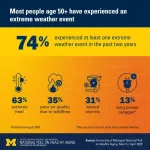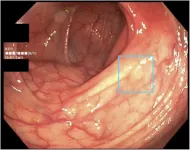(Press-News.org) The answer to your heart health may be on your wrist, a new study suggests. Researchers have developed a new way to assess cardiovascular health based on information routinely collected by smartwatches, according to a study being presented at the American College of Cardiology’s Annual Scientific Session (ACC.25).
According to the findings, dividing the average daily heart rate by the number of steps taken per day provides a more reliable indicator of a person’s cardiovascular fitness compared with either heart rate or step count alone.
“The metric we developed looks at how the heart responds to exercise, rather than exercise itself,” said Zhanlin Chen, a medical student at Northwestern University Feinberg School of Medicine in Chicago and the study’s lead author. “It’s a more meaningful metric because it gets at the core issue of capturing the heart’s capacity to adjust under stress as physical activity fluctuates throughout the day. Our metric is a first attempt at capturing that with a wearable device.”
Heart disease is the leading cause of death in the United States. While several screening tests can provide early warning of heart disease risk, many people do not undergo recommended screenings. Researchers said that taking advantage of the information collected by smartwatches could offer a new strategy to identify people at higher risk and encourage them to speak with a clinician about their heart health.
For the study, researchers analyzed data from nearly 7,000 U.S. adults who provided data from their Fitbit and electronic health records to the All of Us research program, a nationwide prospective study supported by the National Institutes of Health. Together, the data reflected 5.8 million person-days and 51 billion total steps taken.
Calculating the relationship between participants’ average daily heart rate per step (DHRPS) and a variety of cardiovascular outcomes, data showed that people with elevated DHRPS (in the top 25th percentile) were about twice as likely to have Type 2 diabetes, 1.7 times as likely to have heart failure, 1.6 times as likely to have high blood pressure and 1.4 times as likely to have coronary atherosclerosis (a buildup of plaque in the heart’s arteries), compared with people who had lower DHRPS. No relationship was found between DHRPS and the risk of a stroke or heart attack.
The results also showed that DHRPS was more strongly associated with cardiovascular disease diagnoses than either daily heart rate or step count alone. Additionally, in a smaller subset of 21 participants, DHRPS was more strongly linked to maximum metabolic equivalents (METs) achieved on a treadmill stress test than either daily heart rate or step count alone.
Based on the findings, the researchers suggest that DHRPS could be used as an early indicator of who might benefit from more screening tests or cardiovascular conditioning to improve their heart’s functioning. According to Chen, the metric is simple enough that an individual could calculate it on their own based on the data collected by a smartwatch, or it could potentially be built into smartwatch applications.
However, he added that the study offers only an initial validation of the DHRPS approach, and the cross-sectional study design did not allow researchers to determine when the Fitbit measurements were taken relative to when cardiovascular disease outcomes were diagnosed. Moving forward, the researchers hope to conduct more prospective studies with a higher temporal resolution, tracking DHRPS at the scale of minutes rather than aggregated data across days.
With further refinement and validation, Chen said that DHRPS or a similar metric could ultimately be incorporated into the standard heart disease risk assessment that clinicians use.
“Wearables are welcomed by the consumer and worn throughout the day, so they actually have minute-to-minute information about the heart function,” Chen said. “That is a lot of information that can tell us about a lot of things, and there’s a need to further study how this detailed information correlates with patient outcomes.”
Chen will present the study, “Daily Heart Rate Per Step (DHRPS) as a New Wearables Metric Associated with Cardiovascular Disease,” on Saturday, March 29, 2025, at 9:30 a.m. CT / 14:30 UTC in Moderated Poster Theater 10.
ACC.25 will take place March 29-31, 2025, in Chicago, bringing together cardiologists and cardiovascular specialists from around the world to share the newest discoveries in treatment and prevention. Follow @ACCinTouch, @ACCMediaCenter and #ACC25 for the latest news from the meeting.
The American College of Cardiology (ACC) is the global leader in transforming cardiovascular care and improving heart health for all. As the preeminent source of professional medical education for the entire cardiovascular care team since 1949, ACC credentials cardiovascular professionals in over 140 countries who meet stringent qualifications and leads in the formation of health policy, standards and guidelines. Through its world-renowned family of JACC Journals, NCDR registries, ACC Accreditation Services, global network of Member Sections, CardioSmart patient resources and more, the College is committed to ensuring a world where science, knowledge and innovation optimize patient care and outcomes. Learn more at ACC.org.
###
END
Mammograms, with the help of artificial intelligence (AI) models, may reveal much more than cancer, according to a study being presented at the American College of Cardiology’s Annual Scientific Session (ACC.25). The findings highlight how these important cancer screening tools can also be used to assess the amount of calcium buildup in the arteries within breast tissue—an indicator of cardiovascular health.
The U.S. Centers for Disease Control and Prevention recommends that middle-aged and older women get a mammogram—an X-ray of the breast—to screen for breast cancer every one or two ...
DALLAS, March 20, 2025 — Stroke is the fourth leading cause of death in India and the fifth leading cause of disability.[1] To establish a coordinated system of care for stroke in the country, Apollo Hospital in Hyderabad, Telangana, and Aster Hospital in Calicut, Kerala, are the first in India to be certified as Comprehensive Stroke Centers by the American Stroke Association.
Launched in India last year, certifications from American Stroke Association, a division of the American Heart Association, devoted to a world ...
Nearly 3 out of every 4 older Americans have experienced at least one extreme weather event in the last two years, a new University of Michigan poll finds. And living through such an event appears to make a big difference in how they view the potential impact of climate change on their health.
The new findings from the National Poll on Healthy Aging show that 59% of people aged 50 and over are concerned about how climate change could affect their health.
The percentage expressing concern was even higher among those who had recently lived through a weather ...
Complex materials such as organic semiconductors or the microporous metal-organic frameworks known as MOFs are already being used for numerous applications such as OLED displays, solar cells, gas storage and water extraction. Nevertheless, they still harbour a few secrets. One of these has so far been a detailed understanding of how they transport thermal energy. Egbert Zojer’s research team at the Institute of Solid State Physics at Graz University of Technology (TU Graz), in collaboration with colleagues from TU Vienna and the University of Cambridge, has now cracked this ...
Women with polycystic ovary syndrome (PCOS) find it harder to get pregnant, have more frequent miscarriages and have a higher risk of developing endometrial cancer. Now, in a new study published in Nature Medicine, Swedish researchers have shown that the uterine lining of these women differs in terms of both the composition of individual cells and gene expression. The results open the door to new drug treatments.
PCOS is the most common hormonal disorder affecting 11-13% of women of reproductive age. Women with the syndrome have difficulty getting pregnant and are at increased ...
As animals experience new things, the connections between neurons, called synapses, strengthen or weaken in response to events and the activity they cause in the brain. Neuroscientists believe that synaptic plasticity, as these changes are called, plays an important role in storing memories.
However, the rules governing when and how much synapses change are not well understood. The traditional view is that the more two neurons fire together, the stronger their connection becomes; when they fire separately, their connection weakens.
New research ...
Scientists from the RIKEN Center for Emergent Matter Science (CEMS) and collaborators have discovered a groundbreaking way to control superconductivity—an essential phenomenon for developing more energy-efficient technologies and quantum computing—by simply twisting atomically thin layers within a layered device. By adjusting the twist angle, they were able to finely tune the “superconducting gap,” which plays a key role in the behavior of these materials. The research was published in Nature Physics.
The superconducting gap is the energy threshold required to break apart Cooper pairs—bound electron pairs that enable superconductivity at low temperatures. ...
New Haven, Conn. — Advances in the gene-editing technology known as CRISPR-Cas9 over the past 15 years have yielded important new insights into the roles that specific genes play in many diseases. But to date this technology — which allows scientists to use a “guide” RNA to modify DNA sequences and evaluate the effects — is able to target, delete, replace, or modify only single gene sequences with a single guide RNA and has limited ability to assess multiple genetic changes simultaneously.
Now, however, Yale scientists have developed a series of sophisticated mouse models using CRISPR (“clustered regularly ...
The American Gastroenterological Association (AGA) released a new clinical guideline making no recommendation — for or against — the use of computer-aided detection systems (CADe) in colonoscopy. A rigorous review of evidence showed that artificial intelligence-assisted technology helps identify colorectal polyps. However, its impact on preventing colorectal cancer — the third most common cancer worldwide — remains unclear.
Colonoscopy, performed more than 15 million times annually in the U.S., is an effective tool for detecting and preventing colorectal cancer. CADe systems have been shown to improve polyp detection ...
For the first time scientists have identified promising drug candidates that bind irreversibly with a notoriously “undruggable” cancer protein target, permanently blocking it.
Transcription factors are proteins that act as ‘master switches’ of gene activity and play a key role in cancer development. Attempts over the years to design “small molecule” drugs that block them have been largely unsuccessful, so in recent years scientists have explored using peptides – small protein fragments – to block these “undruggable” targets.
Now researchers from the University of Bath have for ...


